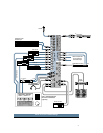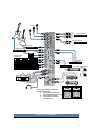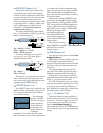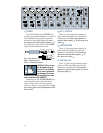
12
L
MONO
L
MONO
L
MONO
L
MONO
LINE IN 7
–
8
RR
R
R
LINE IN 9
–
10
LINE IN 11
–
12
LINE IN 13
–
14
BAL
OR
UNBAL
BAL
OR
UNBAL
BAL
OR
UNBAL
BAL
OR
UNBAL
LINE IN 3
LINE IN 4
L
R
1
2
1
2
RIGHT
AUX SEND
STEREO AUX RETURN
MAIN OUT
LOW CUT
75 Hz
18dB/OCT
LOW CUT
75 Hz
18dB/OCT
BAL
OR
UNBAL
BAL
OR
UNBAL
LINE IN 5
LOW CUT
75 Hz
18dB/OCT
BAL
OR
UNBAL
LINE IN 6
LOW CUT
75 Hz
18dB/OCT
BAL
OR
UNBAL
LINE IN 1
LINE IN 2
MIC
1
MIC
2
MIC
3
MIC
4
LEFT/
MONO
BAL/UNBAL
LOW CUT
75 Hz
18dB/OCT
LOW CUT
75 Hz
18dB/OCT
BAL
OR
UNBAL
BAL
OR
UNBAL
ALL BAL/UNBAL
MIC
5
MIC
6
TRIM
TRIM TRIM TRIM
TRIM
TRIM
LEVEL
+4
-10 -10 -10 -10
LEVEL
+4
LEVEL
+4
LEVEL
+4
TRIM
TAPE
INPUT
TAPE
OUTPUT
L
R
M
I
C
G
A
I
N
+15dB
-45dB
-
1
0
d
B
V
0
60
M
I
C
G
A
I
N
+15dB
-45dB
-
1
0
d
B
V
0
60
M
I
C
G
A
I
N
+15dB
-45dB
-
1
0
d
B
V
0
60
M
I
C
G
A
I
N
+15dB
-45dB
-
1
0
d
B
V
0
60
M
I
C
G
A
I
N
+15dB
-45dB
-
1
0
d
B
V
0
60
M
I
C
G
A
I
N
+15dB
-45dB
-
1
0
d
B
V
0
60
X
D
R
M
I
C
P
R
E
X
D
R
M
I
C
P
R
E
X
D
R
M
I
C
P
R
E
X
D
R
M
I
C
P
R
E
X
D
R
M
I
C
P
R
E
X
D
R
M
I
C
P
R
E
U U U
U
U U
STEREO LINE INPUTS (Channels 7–8,
9–10, 11–12 and 13–14)
These fully balanced inputs are designed for
stereo or mono, balanced or unbalanced sig-
nals, from –10dBV to +4dBu. They can be used
with just about any professional or semi-pro in-
strument, effect or tape player. To learn how
signals are routed from these inputs:
. To
wire your own cables:
.
In the stereo audio world, an odd-numbered
channel usually receives the “left signal.” For
example, you would feed the 1402-VLZ
PRO’s
line inputs 7–8 a stereo signal by inserting the
device’s left output plug into the Channel 7
jack, and its right output plug into the Chan-
nel 8 jack.
When connecting a mono device (just one
cord), always use the Left (
MONO
) input and
plug nothing into the Right input — this way
the signal will appear on both sides. This trick
is called “jack normalling”
.
EFFECTS: SERIAL OR
PARALLEL?
The next two sections toss
the terms “serial” and “paral-
lel” around like hacky sacks.
Here’s what we mean by them.
“Serial” means that the entire signal is
routed through the effects device. Examples:
compressor/limiters, graphic equalizers. Line-
level sources can be patched through a serial
effects device before or after the mixer or,
more conveniently, through the channel insert
jacks located on the rear of the mixer (
INSERT
SEND/RETURN
) .
“Parallel” means that a portion of the signal
in the mixer is tapped off to the device (
AUX
SEND
), processed and returned to the mixer
(
AUX RETURN
) to be mixed with the original
“dry” signal. This way, multiple channels can all
make use of the same effects device. Examples:
reverb, digital delay. (See diagrams below.)
Dry Signal
Serial Device
(e.g. Compressor)
Processed
Signal
Insert Send Insert Return
Serial
Parallel
Dry Signal(s)
Dry Signal(s)
Parallel Device
(e.g. Reverb)
Aux Send
Aux Return
Wet Signal
Channel Path
Mix Stage
Output Section
Processed
Signal
Signal Processor
Signal Processor


















